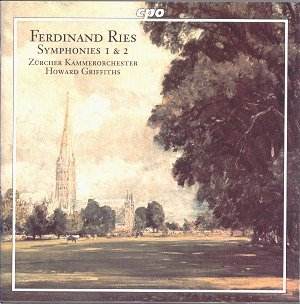Ferdinand RIES (1784-1838)
Symphony no.1 in D, op.23
Symphony no.2 in C, op.80
 Zurich Chamber Orchestra/Howard
Griffiths
Zurich Chamber Orchestra/Howard
Griffiths
Rec Neumünsterkirche, Zürich, 21-24 Sept 1999
 CPO 999 716-2
[52.30]
CPO 999 716-2
[52.30]
Crotchet AmazonUK
AmazonUS
Amazon
recommendations

The contemporaries of Haydn and Mozart - Dittersdorf, Vanhal and so on -
have long been happy hunting grounds for revivalists with a small chamber
orchestra at their disposition. So, increasingly, have the romantics of the
mid-19th Century - Gade, Raff and even the British Potter and
Macfarren. The impression has rather remained that such was the power of
Beethoven's genius that he alone spoke for his day and age (remember that
Schubert, if Beethoven's younger contemporary, belonged really to the following
generation). Did Beethoven really intimidate his contemporaries into abject
imitation?
If we turn to the Second Symphony of Beethoven's pupil and friend
Ferdinand Ries, the answer would appear to be 'yes'. The first movement seems
to have a doppelganger accompanying it and that doppelganger
is the first movement of the Eroica. It is a curious and instructive
experience to hear turns of phrase, rhythmic patterns and modulations (an
outrageous example of the latter in the slow movement, too) which seem so
familiar, but which are reduced to idle, if agreeable, table-talk. It's also
true that Griffiths spins the piece along at a fair lick, but I am sure he
is right and it would never take the weight a Klemperer brought to bear on
the corresponding movement of the Eroica. If you want a classical
symphony to do the washing-up to, then far better this than blaspheme the
Eroica itself.
However, the finale brings an apparent borrowing which cannot be - from the
last movement of Schubert's 4th, written two years later. Yet
the parallel use of lyrical themes upheld by a repetitive rhythmic trajectory
is uncanny (I refer to the minor-key sections, not the monstrous crib from
Beethoven 5 finale when it goes into the major).
But there was more to Ries than this. The slow introduction to the First
Symphony is ear-catching in its harmonic progressions (and Griffiths
extracts a maximum of poetry from it, with some really beautiful wind solos)
and the main body of the movement incorporates a wide range of thematic material.
Without striking individuality, the themes do not recall specific Beethovenian
models (except at one point in the Marche funèbre; the
booklet-notes writer proudly says it bears little resemblance to the
Eroica funeral march. Indeed it doesn't, but it quotes almost
note-for-note that of the op.26 Piano Sonata). More fascinatingly, the whole
work, in part because of its imaginative orchestration, sounds considerably
later than its date. Listening blind I would have taken it for a conservative
post-Schubertian, post-Mendelssohnian romantic work by someone like Gade.
So, the First is a minor find and the Second is at least good fun. The
performances are unlikely to be bettered and the recording is warm and pleasant
if a little over-reverberant (note that it was made in a church). The booklet
notes, in three languages, gives a very full background to Ries and his times
although they may overstate the case for the works themselves. The musically
curious (all of us, I would like to think) need not hesitate.
Christopher Howell

